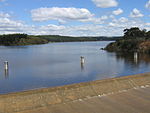Para Wirra Conservation Park
1962 establishments in AustraliaConservation parks of South AustraliaIUCN Category IIIPages with non-numeric formatnum argumentsProtected areas established in 1962 ... and 2 more
Protected areas in AdelaideUse Australian English from June 2015

Para Wirra Conservation Park (formerly Para Wirra Recreation Park and Para Wirra National Park) is a 1,417-hectare (3,500-acre) protected area located in the foothills of the Mount Lofty Ranges in the northern end of the Adelaide metropolitan area in South Australia. The conservation park is part of a larger, 2,573-hectare (6,360-acre) block of contiguous native vegetation, the remainder of which is owned by PIRSA Forestry, SA Water and private landholders.
Excerpt from the Wikipedia article Para Wirra Conservation Park (License: CC BY-SA 3.0, Authors, Images).Para Wirra Conservation Park
Ke12 Track, Adelaide Hills Council
Geographical coordinates (GPS) Address External links Nearby Places Show on map
Geographical coordinates (GPS)
| Latitude | Longitude |
|---|---|
| N -34.680671817 ° | E 138.830080914 ° |
Address
Para Wirra Conservation Park
Ke12 Track
5231 Adelaide Hills Council
South Australia, Australia
Open on Google Maps





